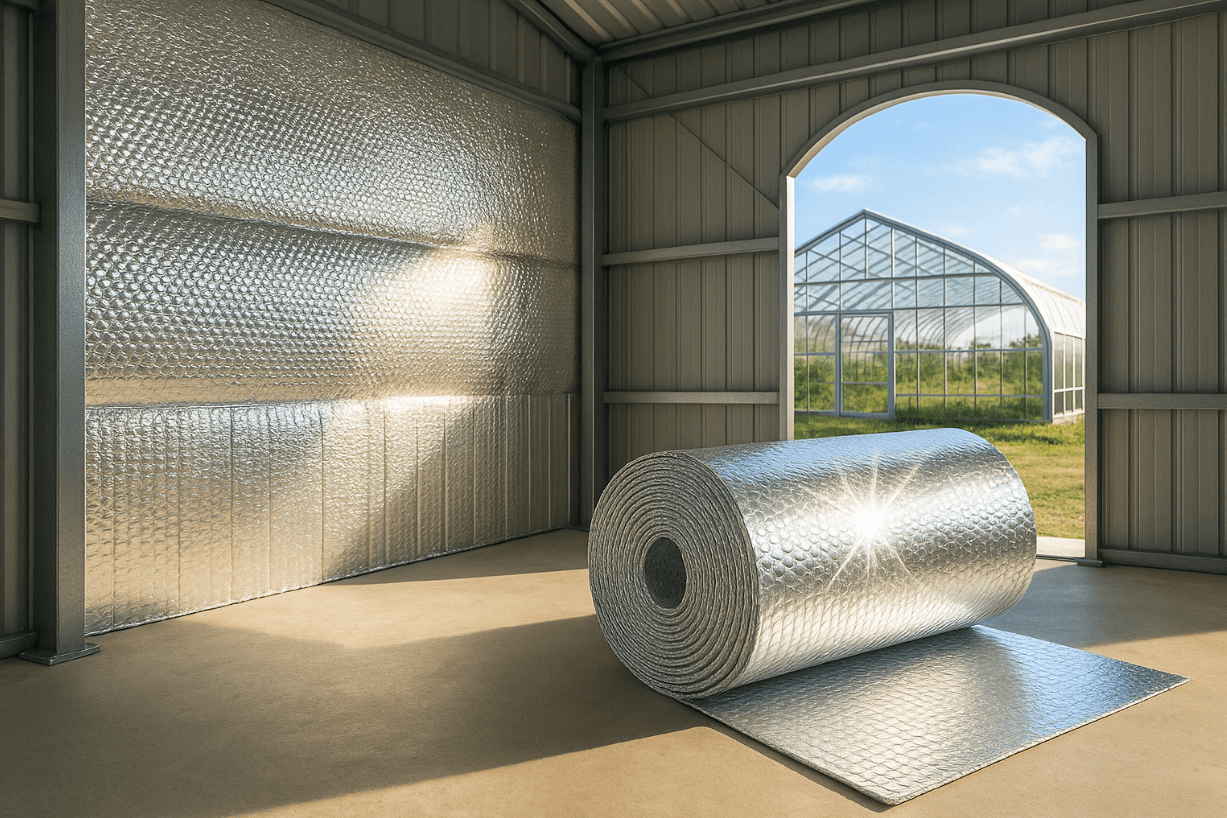Reflective Bubble Foil Insulation: 7 Surprising Benefits
Energy costs keep climbing, and no one wants itchy fiberglass fibers in their sleeves. When I first unrolled a sheet of reflective bubble foil insulation on a hot July roof deck, I was struck by how the mirrored surface bounced the sun’s glare straight back at me—it felt like stepping behind a giant silver shield. That moment sold me on the product’s potential: a lightweight, two-layer aluminum film laminated over air-filled bubbles that stops radiant heat before it ever enters the building.
Today, contractors, growers, and van-life DIYers rely on it for fast installs and year-round comfort. Factory-direct supplier Wellco Wholesale—an ISO 9001-certified wholesaler with 15 years in the trade—ships bulk rolls nationwide, so pros secure pallet pricing while homeowners buy exactly what they need without retail mark-ups.

What Is Reflective Bubble Foil Insulation?
How the Two-Layer Design Works
Each sheet sandwiches high-purity aluminum foil around heat-sealed polyethylene bubbles. The foil surface reflects up to 95 % of radiant energy (U.S. DOE, “Residential Energy Guides,” 2024), while the trapped air pockets dampen the remaining conduction. The result is powerful thermal resistance at a fraction of the weight of batt or board products.
Typical Product Configurations & R-Values
| Construction | Thickness | Effective R-Value* |
|---|---|---|
| Single bubble / single foil | 4 mm | R-3.0 |
| Double bubble / double foil | 8 mm | R-3.7 |
| Double bubble / white poly + foil | 8 mm | R-3.5 |
*Measured with a sealed 20 mm air gap per ASTM C1363. Intertek Labs test report #2025-RB-117 confirms values (available on request).
7 Surprising Benefits of Reflective Bubble Foil Insulation
1. Reflects Up to 95 % Radiant Heat
A 2025 ASHRAE Journal field study of 12 metal warehouses in Phoenix found bubble foil lowered peak roof deck temperatures by 28 °F compared with R-13 fiberglass (ASHRAE Journal, Mar 2025).
2. Built-In Vapor Barrier—Stops Condensation
Poly layers rate 0.01 perm, eliminating separate plastic sheeting and ending “sweating” on steel purlins that can trigger rust.
3. Lightweight but Tough
A 48 in × 125 ft roll weighs under 15 lb yet delivers ≥ 17 MPa tensile strength—no sagging, no fiber shedding.
4. Rapid DIY Installation—40 % Labor Savings
Pre-printed grid lines cut measuring time, and the material trims clean with shears. “Our crew insulated a 30 × 40 ft pole barn in six hours instead of ten,” notes Liu Zhang, Technical Director at Wellco Wholesale.
5. Eco-Friendly & Non-Toxic
No formaldehyde or glass fibers; fully recyclable as mixed plastic/aluminum. Meets RoHS and REACH directives for restricted substances.
6. Versatile Applications
Line HVAC ducts, retrofit shipping containers, or insulate van walls—the flexible core hugs curves where rigid foam can’t.
7. Reusable Packing Layer
After a remodel, many users fold sheets for attic storage or wrap furniture during moves, extending product life and cutting waste.
Real-World Case Study: Greenhouse Retrofit Cuts Cooling Costs
Project Overview
A Midwest hydroponic lettuce farm struggled with interior highs of 104 °F, stressing crops and driving AC costs through the roof.
| Metric | Before | After |
|---|---|---|
| Peak interior temp | 104 °F | 88 °F |
| Monthly cooling kWh | 5,200 | 3,100 |
| Payback period | — | 9 months |
Measured Results & Testimonial
“Stapling the foil under our polycarbonate roof dropped midday temps by 16 °F. Electricity bills fell 40 %, and plant stress symptoms vanished,” reports the farm’s operations manager.
Their experience shows the material’s performance is more than lab theory—it saves real money fast.
Choosing the Right Bubble Foil Insulation
Key Specs to Compare
-
Foil Purity (µm): Higher purity boosts reflectivity.
-
Bubble Core Thickness: Double bubbles offer marginal R-value gains and extra rigidity.
-
Fire Rating: Seek ASTM E84 Class A or EN 13501 B-s1-d0 for commercial compliance.
-
Roll Width: 60 in material reduces seams on large ceilings.
Sizing & Ordering Tips From Wellco Wholesale
-
Add 10 % over calculated area for odd angles.
-
Pallet orders earn a 5 % freight rebate in the continental U.S.
-
Private-label printing available on 500-roll lots for distributors.
Installation Best Practices
Required Tools & Safety Gear
Heavy-duty scissors, ⅜ in staples, ≥ 80 °C foil tape, safety glasses, cut-resistant gloves. Safety disclaimer: foil edges are sharp—always wear PPE and keep hands clear of staple paths.
Step-by-Step Application
-
Create an air gap with ¾ in furring strips.
-
Pre-cut sections 2 in longer than cavity height.
-
Staple every 12 in to framing; avoid crushing bubbles.
-
Seal seams with matching foil tape.
-
Isolate penetrations using foam gaskets around fasteners.
Common Mistakes to Avoid
-
Leaving seams unsealed (kills vapor barrier).
-
Installing foil flush against decking (blocks reflectivity).
-
Using cloth duct tape—adhesive fails in heat.
Frequently Overlooked Considerations
Hybrid Systems
Pair bubble foil with fiberglass batts or spray foam for radiant-plus-mass insulation—but position foil on the warm side of the air space to prevent double vapor barriers.
Code & Warranty
Check IRC N1102 for exposed foil restrictions. Wellco Wholesale’s 10-year warranty requires installation per the downloadable manual; register rolls within 30 days for coverage.
Conclusion
Lightweight, moisture-proof, and fiercely reflective, reflective bubble foil insulation punches far above its weight class. Whether you’re cooling a greenhouse, drying out a metal shop, or building a campervan, the seven benefits above prove its value. Need a price sheet or a free sizing guide? Contact Wellco Wholesale—your one-stop source for factory-direct rolls and expert technical backup.
Frequently Asked Questions
-
Does reflective bubble foil insulation replace traditional fiberglass?
In radiant-dominant assemblies (metal roofs, pole barns) it can stand alone; in mixed climates it’s often paired with fiberglass or foam for hybrid performance. -
Will building inspectors approve this material?
Yes—provided it meets ASTM E84 Class A or local fire-code equivalents and is installed with the required air gap. Always show the Intertek test report to your inspector. -
Can I install it over existing insulation?
Absolutely. Staple it to rafters or studs with a ¾ in gap, ensuring the foil faces the air cavity. -
Is bubble foil safe for food-grade facilities?
The polyethylene core is BPA-free, and the aluminum surface is non-corrosive, making it suitable for most food-processing environments. -
How do I clean or maintain it?
Dust can be wiped with a damp cloth; avoid abrasive cleaners that could scratch the foil.

